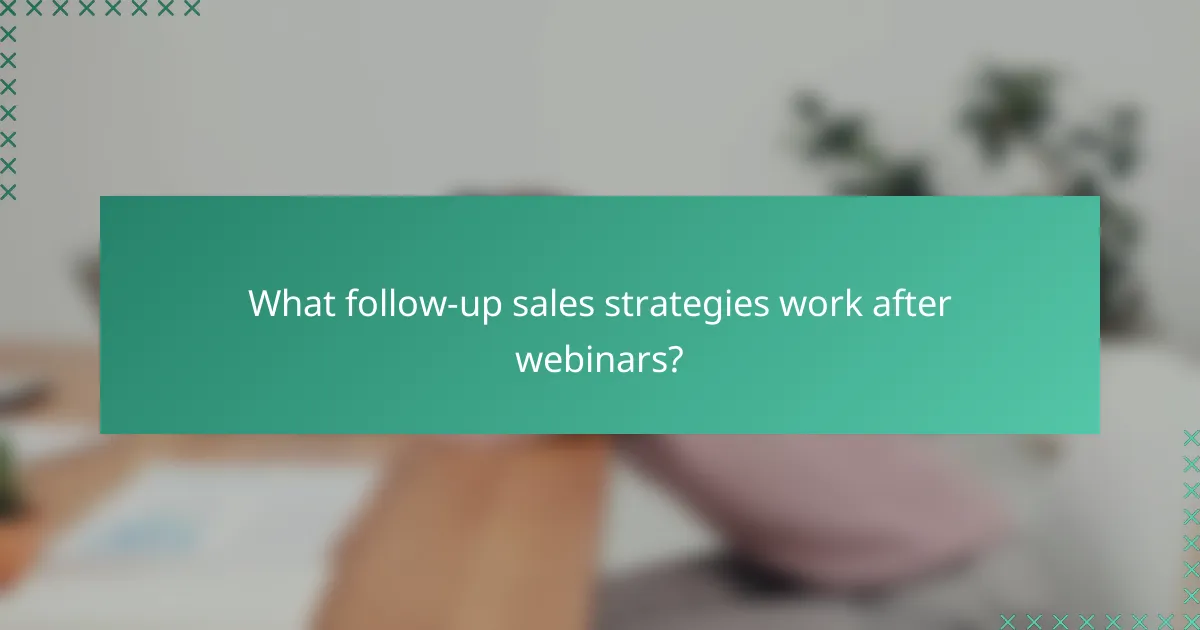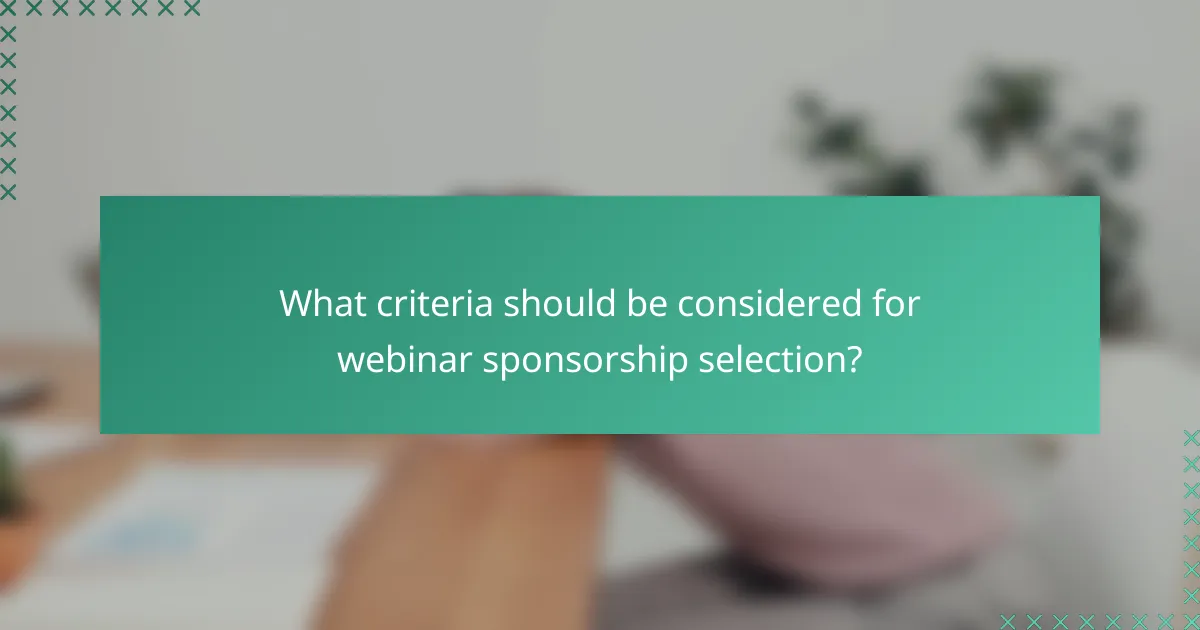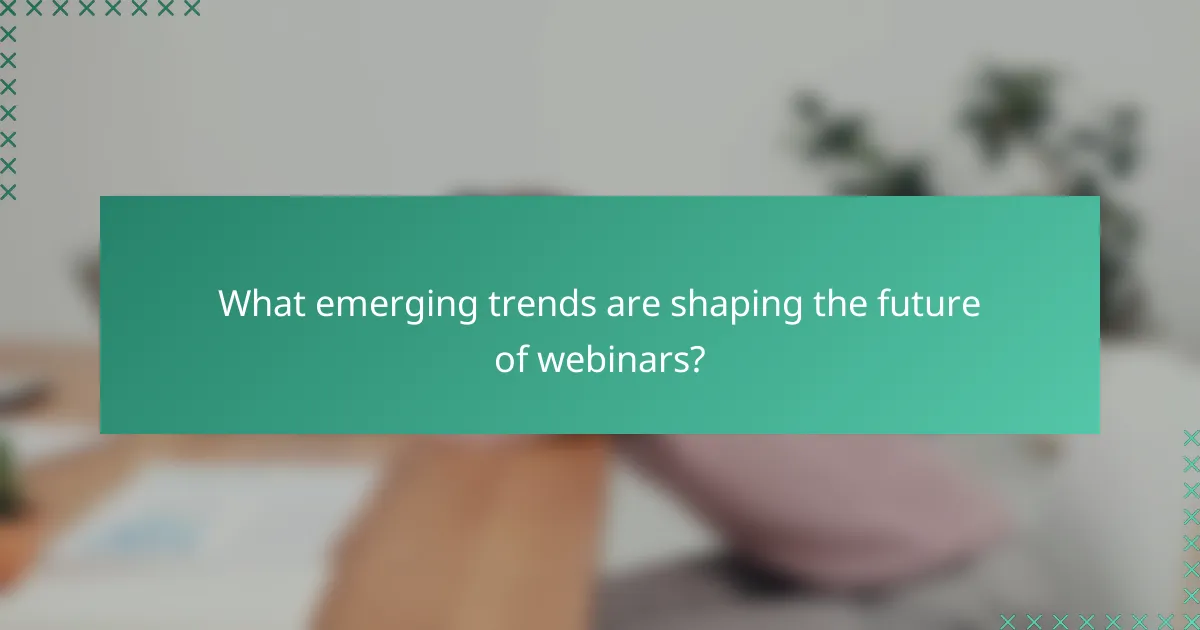Webinars present a unique opportunity for brands to connect with targeted audiences while enhancing sponsorship potential through measurable engagement. By effectively following up with attendees and incorporating interactive elements, businesses can convert interest into sales and foster a more engaged community. Utilizing strategies like targeted emails and real-time feedback can significantly elevate the overall webinar experience for both sponsors and participants.

How can webinars drive sponsorship opportunities?
Webinars can significantly enhance sponsorship opportunities by connecting brands with targeted audiences and providing measurable engagement metrics. This platform allows sponsors to showcase their products or services directly to interested participants, creating a mutually beneficial relationship.
Targeted audience reach
Webinars attract specific demographics, allowing sponsors to reach potential customers who are genuinely interested in their offerings. By selecting topics that resonate with their target market, sponsors can ensure that their message is delivered to an engaged audience.
For example, a tech company sponsoring a webinar on cybersecurity can effectively connect with IT professionals and decision-makers, maximizing the relevance of their marketing efforts. This focused approach often leads to higher conversion rates compared to broader advertising methods.
Brand visibility enhancement
Sponsoring webinars provides brands with increased visibility among a captive audience. During the event, sponsors can showcase their logos, products, and services, reinforcing brand recognition and credibility.
Additionally, sponsors can leverage promotional materials, such as pre-event emails and social media posts, to further enhance their visibility. This multi-channel approach helps to solidify the brand’s presence in the minds of potential customers.
Engagement metrics for sponsors
Webinars offer valuable engagement metrics that sponsors can use to assess the effectiveness of their investment. Metrics such as attendance rates, participant feedback, and post-event interactions provide insights into audience interest and engagement levels.
By analyzing these metrics, sponsors can refine their strategies for future webinars, ensuring that they continue to resonate with their target audience. This data-driven approach allows for continuous improvement and maximizes the return on investment for sponsorships.

What follow-up sales strategies work after webinars?
Effective follow-up sales strategies after webinars include targeted email marketing, personalized calls, and exclusive offers. These approaches help convert attendees into customers by maintaining engagement and addressing their specific needs.
Email marketing campaigns
Email marketing campaigns are a powerful way to follow up with webinar attendees. Sending a thank-you email shortly after the event can reinforce the connection and provide valuable resources discussed during the webinar.
Consider segmenting your email list based on attendee behavior, such as those who asked questions or downloaded materials. Tailored messages can increase engagement and conversion rates, often ranging from 15% to 30% for well-targeted campaigns.
Personalized follow-up calls
Personalized follow-up calls can significantly enhance your sales efforts post-webinar. Reaching out to attendees with a direct call allows for a more personal touch, enabling you to address specific questions and concerns.
When making calls, prepare a brief script that includes key points from the webinar and potential solutions for the attendee’s needs. Aim to connect within a week after the webinar to maintain momentum and interest.
Exclusive offers for attendees
Offering exclusive deals to webinar attendees can incentivize them to make a purchase. This could include discounts, free trials, or bundled services that are only available for a limited time.
Highlight the value of these offers in your follow-up communications. For instance, a 20% discount on a product discussed during the webinar can create urgency and encourage quick decisions, enhancing your overall conversion rates.

How to enhance audience engagement during webinars?
Enhancing audience engagement during webinars involves incorporating interactive elements that encourage participation and feedback. Effective strategies include using polls, gamification, and real-time feedback mechanisms to create a dynamic and interactive experience.
Interactive polls and Q&A sessions
Interactive polls and Q&A sessions are powerful tools for engaging your audience. Polls can be used to gauge opinions or knowledge on specific topics, allowing participants to feel involved and heard. Aim to include at least two or three polls throughout the webinar to maintain interest.
Q&A sessions provide an opportunity for attendees to ask questions directly, fostering a sense of community. Schedule these sessions strategically, either at the end or after key segments, to keep the flow of information balanced and engaging.
Gamification elements
Incorporating gamification elements can significantly boost audience engagement. This can include quizzes, challenges, or leaderboards that reward participation with points or prizes. Simple quizzes related to the webinar content can enhance retention and make learning enjoyable.
Consider using tools that allow for real-time scoring and feedback, which can motivate participants to stay engaged throughout the session. Keep the gamification elements relevant to the topic to ensure they enhance, rather than distract from, the main content.
Real-time feedback mechanisms
Real-time feedback mechanisms allow you to adjust your presentation based on audience reactions. Tools like chat functions or emoji reactions can provide immediate insights into how well the content is being received. Encourage attendees to use these features to express their thoughts during the webinar.
Additionally, consider implementing post-webinar surveys to gather more detailed feedback. This not only helps improve future webinars but also shows attendees that their opinions are valued, fostering a stronger connection with your audience.

What criteria should be considered for webinar sponsorship selection?
When selecting sponsors for a webinar, it’s essential to consider alignment with the target audience, brand reputation, and shared values. These criteria ensure that the sponsorship enhances the event’s credibility and resonates with attendees.
Target audience alignment
Understanding the target audience is crucial for effective webinar sponsorship. Sponsors should have products or services that appeal to the same demographic as the webinar participants. For example, a tech webinar may attract sponsors from software companies or hardware manufacturers.
To evaluate alignment, consider conducting surveys or analyzing past attendee data. This information helps identify which brands will likely engage the audience and contribute to a successful event.
Brand reputation and values
Choosing sponsors with a strong, positive brand reputation is vital for maintaining the webinar’s integrity. Brands that are well-regarded in their industry can enhance the perceived value of the webinar. For instance, partnering with a leading company in sustainability for an environmental webinar can reinforce the event’s message.
Additionally, ensure that the sponsor’s values align with those of the webinar’s theme. Mismatched values can lead to audience disengagement and damage both the sponsor’s and the webinar’s reputation. A quick review of the sponsor’s mission statement and recent initiatives can provide insight into their alignment.

What are the best platforms for hosting webinars in 2023?
In 2023, the best platforms for hosting webinars include Zoom, Webex Events, and GoToWebinar. These platforms offer various features tailored for business needs, such as audience engagement tools, analytics, and integration capabilities.
Zoom for Business
Zoom for Business is widely recognized for its user-friendly interface and robust features. It allows hosts to conduct webinars with up to several thousand participants, making it suitable for large audiences.
Key features include interactive polls, Q&A sessions, and breakout rooms, which enhance audience engagement. Consider using Zoom if you need a platform that integrates well with other tools like Slack or Salesforce.
Webex Events
Webex Events provides a comprehensive solution for hosting webinars and virtual events. It supports high-quality video and audio, ensuring a professional experience for both hosts and attendees.
This platform is particularly beneficial for organizations that require advanced security features and compliance with regulations. Webex Events also offers analytics tools to track engagement and participant feedback effectively.
GoToWebinar
GoToWebinar is known for its simplicity and effectiveness in managing webinars. It allows hosts to reach audiences through features like automated email reminders and customizable registration pages.
With options for live streaming and on-demand webinars, GoToWebinar is ideal for businesses looking to maximize their reach. Its analytics dashboard provides insights into attendee behavior, helping refine future webinars.

What emerging trends are shaping the future of webinars?
Emerging trends in webinars are increasingly focused on interactivity, personalization, and integration with sales processes. As businesses recognize the potential of webinars for engagement and conversion, they are adopting innovative technologies and strategies to enhance viewer experiences and drive follow-up sales.
Sponsorship opportunities in webinars
Sponsorship opportunities in webinars are growing as brands seek to reach targeted audiences effectively. Companies can partner with webinar hosts to showcase their products or services, often gaining access to valuable data on attendee engagement and preferences.
When considering sponsorship, brands should evaluate the alignment of the webinar’s content with their target market. This ensures that their message resonates with attendees, increasing the likelihood of conversion. Offering tiered sponsorship packages can also attract a wider range of sponsors, from startups to established enterprises.
Follow-up sales strategies after webinars
Follow-up sales strategies after webinars are crucial for converting leads into customers. Engaging with attendees shortly after the event can significantly increase the chances of closing deals. This can be done through personalized emails, offering additional resources, or scheduling one-on-one consultations.
It’s beneficial to segment attendees based on their engagement levels during the webinar. For instance, those who asked questions or downloaded materials may be more inclined to receive targeted follow-ups. Implementing a structured follow-up timeline, such as within 48 hours post-webinar, can enhance responsiveness.
Enhancing audience engagement during webinars
Enhancing audience engagement during webinars is key to maintaining interest and ensuring a productive experience. Utilizing interactive tools such as polls, Q&A sessions, and chat features can create a dynamic environment that encourages participation.
To maximize engagement, presenters should aim for a conversational tone and encourage audience interaction throughout the session. Additionally, keeping webinars concise—ideally under 60 minutes—can help maintain attention and reduce drop-off rates. Incorporating real-time feedback mechanisms can also provide insights into audience preferences and improve future webinars.
